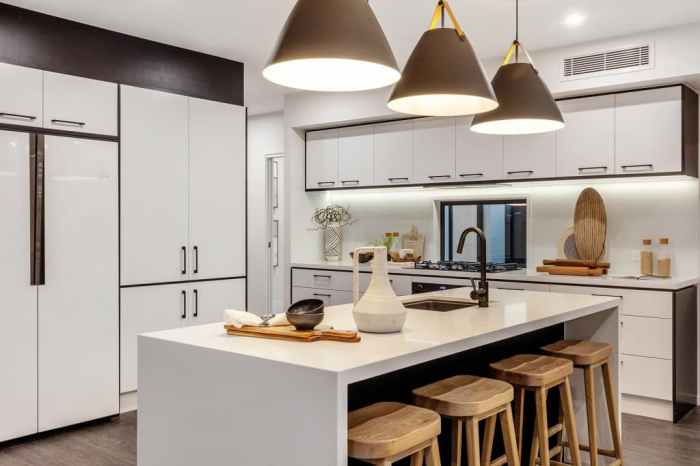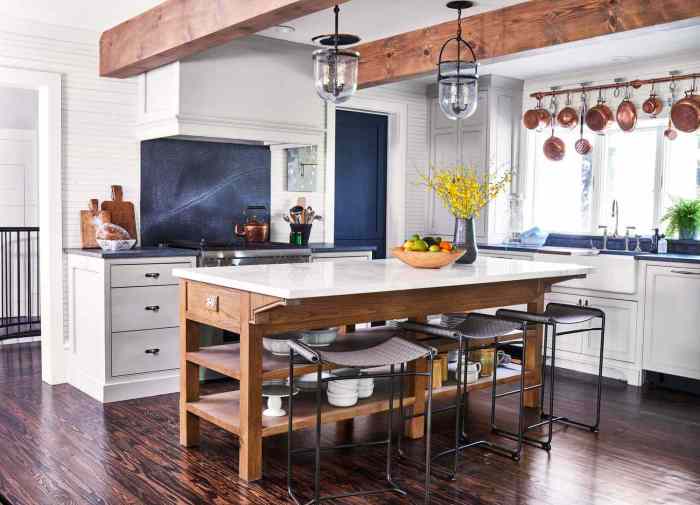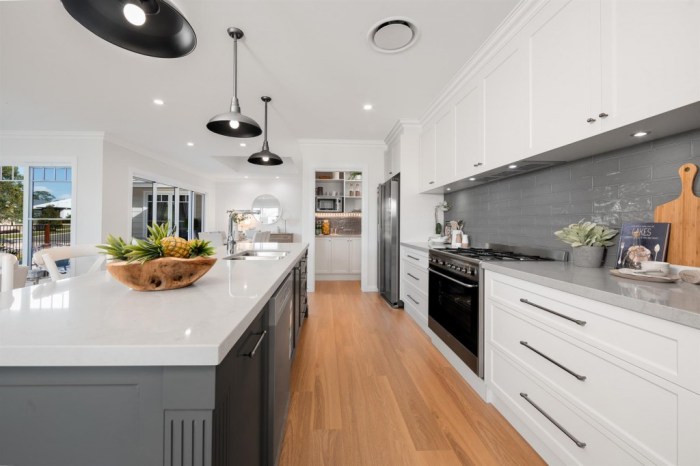Transforming your kitchen from a mere cooking space into a highly functional and aesthetically pleasing hub requires careful planning and consideration. This guide provides ten expert tips to help you design a kitchen that seamlessly integrates style and efficiency, maximizing space and optimizing workflow for a truly enjoyable culinary experience. We’ll explore everything from layout optimization and smart storage solutions to choosing the right appliances and fixtures.
From understanding the crucial work triangle to mastering creative storage solutions for even the smallest kitchens, we’ll delve into the practical aspects of kitchen design. We’ll also explore how to select energy-efficient appliances and stylish fixtures that complement your personal style, ensuring your kitchen is both beautiful and sustainable.
Planning & Layout

Effective kitchen design hinges on thoughtful planning and a well-considered layout. Optimizing workflow is paramount, ensuring a smooth and efficient cooking experience. This involves strategic placement of appliances and ample counter space to facilitate seamless movement between key areas. Understanding the principles of the work triangle and considering traffic flow are crucial aspects of this process.
A well-planned kitchen minimizes wasted steps and maximizes efficiency. By strategically positioning the sink, stove, and refrigerator – the vertices of the work triangle – you create a natural flow for food preparation. This reduces unnecessary movement and improves overall kitchen functionality. Furthermore, a well-designed layout incorporates ample counter space for food preparation, ensuring a comfortable and uncluttered cooking environment. Consideration of traffic flow prevents congestion and allows for multiple users to work in the kitchen simultaneously without hindering each other.
Kitchen Layout Examples and Their Benefits
Different kitchen layouts cater to various needs and space constraints. The choice of layout significantly impacts workflow and overall kitchen usability.
| Layout Type | Description | Benefits | Drawbacks |
|---|---|---|---|
| L-Shaped | Appliances and counters are arranged along two adjacent walls, forming an “L” shape. | Offers good counter space and can incorporate an island or peninsula. Suitable for medium-sized kitchens. | May not be ideal for very small or very large kitchens. |
| U-Shaped | Appliances and counters are arranged along three walls, forming a “U” shape. | Maximizes counter and storage space. Provides ample workspace for multiple cooks. | Can feel cramped if not properly designed. Requires a larger kitchen space. |
| Galley | Appliances and counters are arranged on two parallel walls. | Efficient use of space, ideal for smaller kitchens. Promotes a linear workflow. | Limited counter space, can feel cramped if not well-designed. Requires careful planning to avoid bottlenecks. |
Work Triangle and Appliance Placement
The work triangle, connecting the sink, stove, and refrigerator, should ideally measure between 9 and 26 feet in total length. A shorter distance minimizes movement, while a longer distance can disrupt workflow. This principle guides appliance placement to enhance efficiency.
Appliance placement should also consider factors beyond the work triangle. The dishwasher should be near the sink for easy loading and unloading. The oven and microwave should be placed at a comfortable height and within easy reach. Consider the height of family members when determining placement to ensure comfortable usability. For instance, placing frequently used appliances at a height accessible to children or elderly individuals can significantly improve the overall kitchen experience. Additionally, consider incorporating power outlets near appliances and ample lighting above work areas.
Traffic Flow and Counter Space Optimization
Effective kitchen design prioritizes smooth traffic flow, minimizing congestion and maximizing usable space. This means avoiding placement of appliances or furniture that obstruct movement. Sufficient counter space is crucial for food preparation, cooking, and serving.
Counter space should be strategically distributed around the work triangle, providing ample area for each stage of food preparation. Island or peninsula counters can add significant workspace and serve as a central gathering point. Consider the number of people who will regularly use the kitchen when determining the required counter space. A family of four will require more counter space than a single person. Avoid placing appliances directly on countertops, as this reduces valuable workspace. Instead, integrate appliances into cabinetry or use wall-mounted shelving units to maximize available space.
Factors Affecting Appliance Placement
Several factors influence optimal appliance placement, ensuring both efficiency and convenience. These include the size and layout of the kitchen, the frequency of appliance use, and the needs of the household.
Size and layout directly impact the feasibility of different configurations. A smaller kitchen necessitates a more compact layout, prioritizing space-saving designs. Frequent appliance use necessitates placement for easy access. Household needs, such as the number of people using the kitchen and their cooking habits, should be carefully considered. For instance, a family that frequently bakes will require an oven that is easily accessible and well-ventilated. Similarly, a family with young children might need to consider the placement of appliances with safety in mind. The overall aesthetic should also be taken into consideration when making decisions about appliance placement.
Storage Solutions

Efficient storage is paramount in any kitchen, but especially crucial in smaller spaces. Clever storage solutions can transform a cramped kitchen into a functional and organized hub. This section explores various strategies to maximize space and streamline your workflow.
Effective kitchen storage goes beyond simply having enough cabinets; it’s about creating a system that allows for easy access to frequently used items while keeping less frequently used items readily available but out of the way. A well-organized kitchen minimizes clutter and maximizes efficiency, making cooking and cleaning a more enjoyable experience.
Creative Storage Solutions for Small Kitchens
Small kitchens often present a significant storage challenge. However, with a little creativity and planning, even the smallest kitchen can accommodate all its necessities. The following solutions offer practical ways to maximize limited space.
- Vertical Space Maximization: Utilize the often-overlooked vertical space above cabinets or the refrigerator. Install open shelving to display attractive dishes or store infrequently used items. Imagine a sleek, minimalist shelf system above your cabinets, housing decorative items and seldom-used cookware.
- Pull-Out Shelves and Drawers: These are perfect for maximizing corner cabinet space and making items easily accessible. A pull-out shelf in a corner cabinet transforms a typically wasted area into a highly functional space for pots, pans, or baking sheets.
- Magnetic Strips: Install magnetic strips on the inside of cabinet doors or on a wall to hold knives, utensils, or spice tins. Visualize a stainless steel strip neatly holding your favorite chef’s knives, always within easy reach.
- Under-Sink Organizers: Utilize the space under the sink with a tiered organizer to separate cleaning supplies and maximize vertical space. Picture a multi-tiered, slide-out organizer neatly containing your cleaning products, sponges, and dish soap.
- Over-the-Cabinet Organizers: Install organizers on the top of your cabinets to store seldom-used items, freeing up valuable space within the cabinets themselves. This could include a wire basket system holding extra serving dishes or rarely used appliances.
Pantry Organization System
A well-organized pantry is the cornerstone of efficient kitchen management. Implementing a system ensures easy access to ingredients, reduces food waste, and simplifies meal preparation.
Consider categorizing items by type (canned goods, grains, baking supplies, snacks) and arranging them by frequency of use. Frequently used items should be at eye level and easily accessible. Utilize clear containers to store dry goods, allowing for easy identification of contents and preventing spills. Label everything clearly for quick identification. Regularly check expiration dates and discard outdated items to maintain a clean and efficient pantry.
Pull-Out Drawers and Corner Cabinets
Pull-out drawers and corner cabinets are game-changers in kitchen design, significantly improving accessibility and maximizing storage capacity.
Pull-out drawers eliminate the need to reach deep into cabinets, making it easy to find and retrieve items. This is particularly beneficial for heavier items or those stored at the back of a cabinet. Corner cabinets, often underutilized, become highly functional when fitted with pull-out shelves or lazy susans. These mechanisms provide easy access to all corners of the cabinet, preventing items from getting lost or forgotten.
Cabinet Hardware: Functionality and Aesthetics
Cabinet hardware plays a dual role: enhancing functionality and adding aesthetic appeal. The choice of knobs, pulls, or handles significantly impacts the overall look and feel of the kitchen.
Functionality: Consider factors like ease of use, durability, and weight capacity. For example, large, heavy cabinet doors may benefit from robust handles, while smaller doors may suit more delicate knobs. Materials such as stainless steel offer durability, while ceramic or glass options can add a touch of elegance.
Aesthetics: Hardware style should complement the overall kitchen design. Modern kitchens often feature sleek, minimalist handles, while traditional kitchens might opt for ornate knobs. The finish of the hardware (e.g., brushed nickel, polished chrome, oil-rubbed bronze) should also harmonize with other fixtures and appliances.
Appliances and Fixtures

Selecting the right appliances and fixtures is crucial for creating a kitchen that is both efficient and enjoyable to use. The choices you make will impact not only the functionality of your kitchen but also its overall aesthetic and long-term sustainability. Careful consideration of features, durability, and energy efficiency will pay dividends for years to come.
Kitchen Sink Selection
The kitchen sink is a workhorse, enduring daily wear and tear. Choosing the right one depends on your lifestyle and the available space. A single basin sink is ideal for larger pots and pans, offering ample cleaning space. Double basin sinks provide separate areas for washing and rinsing, improving efficiency. Farmhouse sinks, with their deep basins and apron front, offer a rustic charm and significant capacity, but may require more counter space. Consider the material (stainless steel, composite granite, porcelain) based on durability and aesthetic preferences. Stainless steel is a popular choice for its durability and ease of cleaning, while composite granite offers a more modern and stain-resistant option.
Kitchen Faucet Comparison
Kitchen faucets come in a variety of styles and functionalities. Pull-down spray faucets offer flexibility and reach, making cleaning large areas easier. Gooseneck faucets provide a graceful arc and ample clearance for large pots and pans. Touchless faucets enhance hygiene by eliminating the need to touch the handle, while sensor faucets automatically turn the water on and off, conserving water. Consider the faucet’s finish (chrome, brushed nickel, oil-rubbed bronze) to complement your kitchen’s design. High-arc faucets are particularly useful for filling tall pots and pitchers.
Energy-Efficient Appliance Selection
Energy-efficient appliances are essential for a sustainable kitchen. Look for appliances with the Energy Star rating, indicating they meet specific energy-efficiency guidelines. Consider features like LED lighting (for refrigerators and ovens), efficient motors (for dishwashers and refrigerators), and smart technology that allows for precise temperature control and optimized energy usage. Investing in energy-efficient appliances can lead to significant long-term savings on your utility bills and reduce your environmental impact. For example, a high-efficiency refrigerator might use 20% less energy than a standard model over its lifespan.
Essential Kitchen Appliances
A functional kitchen requires a range of appliances categorized by their purpose.
The following list Artikels essential appliances, categorized for clarity:
- Food Preparation: Food processor, blender, stand mixer
- Cooking: Range/oven, microwave oven
- Refrigeration: Refrigerator, freezer
- Cleaning: Dishwasher
Final Summary

Designing a functional kitchen is a rewarding process that blends practicality with personal style. By thoughtfully considering layout, storage, appliances, and fixtures, you can create a space that enhances your cooking experience and elevates your home. Remember, a well-designed kitchen is an investment in comfort, efficiency, and lasting enjoyment. Apply these expert tips to create your dream kitchen—a space where culinary creativity flourishes.